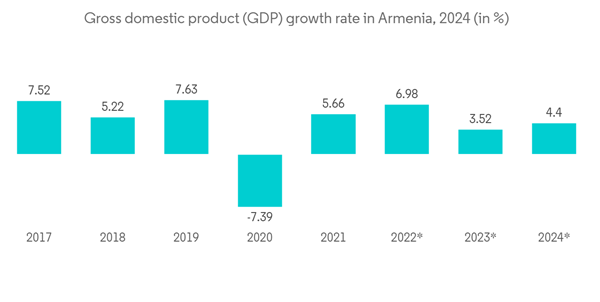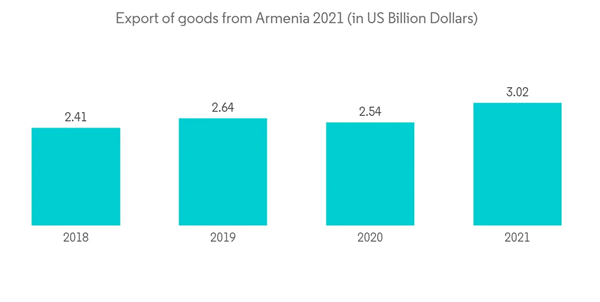Armenia experienced GDP growth of 11 percent during the first half of 2022 compared to the same period in 2021. This strong growth performance was driven mainly by growth in services, particularly tourism, finance, and IT.
Key Highlights
- High demand and high international food and fuel commodity prices pushed Inflation to 10.3 percent in June 2022, with food and fuel price increases accounting for two-thirds of total Inflation.
- According to the Armenian Statistical Committee, the poverty rate in 2020 was 27%. Experts predict the figure will rise to 43 percent due to the combined effects of low agricultural output in Armenia in 2022, lower-than-expected remittances from Russia, and issues the government will have in reducing the impact of Inflation on disadvantaged Armenians.
- Demand is also increasing among small and medium-sized firms (SMEs), who utilize such instruments to conduct transactions with new counterparts, receive better trade terms, and obtain financing under more favorable terms. Armenian banks assist SMEs by providing services tailored to their specific requirements. COVID-19 imposed global limitations and increased worries about the timely supply of goods and services. Government-imposed lockdowns resulted in massive business losses and interrupted operations and supply lines. However, Armenia witnessed the implementation of various government programs to assist businesses in dealing with the impact of the lockdowns and delays.
- Cross-border payments have become well-integrated into corporate operations as international e-commerce grows exponentially. Digitalization and innovation have emerged as critical components for enhancing the consumer experience. The key focus on improvement is to provide smooth, quick, and cheaper cross-border payments for the banks to remain competitive among peers and keep pace with technological progress in the global marketplace.
Armenia Freight & Logistics Market Trends
Increasing Trade with European countries
In the first ten months of 2022, trade turnover between Armenia and Iran surged 45.3% to USD 565.6 million. According to Armenia's National Statistical Committee, the commercial transaction between Armenia and Iran increased by 45.3% from January to October 2022 to USD 565.5 million. Armenian exports to Iran increased by 82.4% yearly to USD 92 million, while imports from Iran increased by 39.1% to USD 474.3 million.According to the National Statistical Committee, Armenia's international commerce increased by 47.7% in the first seven months of 2022 compared to the same period in 2021, reaching over USD 6.4 billion. Foreign trade in July 2022 alone was valued at more than USD 1.2 billion, representing a 67.1% rise over July 2021 and a 0.5% reduction over June 2022. Armenia's trade with EU nations was over USD 1.2 billion, representing a 36.7% increase yearly. Germany (about USD 234.7 million, up 50.1%), Bulgaria (about USD 172.9 million, up 22.9%), Italy (about USD 170.8 million, up 10.3%), the Netherlands (about USD 160.1 million, up 61%), and Belgium (USD 82.4 million, up 42.5%) were the top five most significant trading partners. Armenia's trade with China increased by 29.3% to USD 829 million, dealing with Iran increased by 28.1% to USD 276.8 million, work with the United States increased by 81% to USD 189.2 million, trade with the UAE nearly tripled to USD 189 million, trade with Switzerland decreased by 13% to USD 182 million, and trade with Iraq increased by 57.7% to USD 129, 3 million.
Traction of Armenians towards freight transportation through different modes
Over 8.3 million tons of various goods were transported in Armenia in the first six months of 2022, an 11.2% growth compared to the same period in 2021. The number of transported passengers surged by 40.4%, over 71 million, according to the National Statistics Committee. During the period under review, about 5.7 million tons of cargo were transported by trucks, 12.9% more than in January-June 2021; about 1.5 million tons by rail transport (1% rise ), about 1.2 million tons by trunk pipeline transport (18.4% rise ) and 8,000 tons by air transport (5.3% rise).In the first 6 months of the year 2022, some 56.3 million people were transported by road transport (43.9% growth), 13.2 million by electric transport (25.4% growth), 1.4 million by air (75.6% growth), and 220,900 by rail (22.5% growth). In the reporting period of 2022, revenues from postal and courier activities amounted to about 7.7 billion drams, down 9.8% compared to the same period in 2021.
Armenia Freight & Logistics Industry Overview
The Armenia freight and logistics market is fragmented, with the dominating presence of local players. The major international players present in the country are CEVA, DHL, and Hellmann Worldwide Logistics, to name a few. The country has high logistics costs. As a result, there is stiff competition in to maintain competitive pricing.Additional Benefits:
- The market estimate (ME) sheet in Excel format
- 3 months of analyst support
This product will be delivered within 2 business days.
Table of Contents
1 INTRODUCTION1.1 Study Assumptions and Market Definition
1.2 Scope of the Study
2 RESEARCH METHODOLOGY
3 EXECUTIVE SUMMARY
4 MARKET DYNAMICS AND INSIGHTS
4.1 Market Overview
4.2 Market Dynamics
4.2.1 Drivers
4.2.2 Restraints
4.2.3 Opportunity
4.3 Technology Innovation in the Freight and Logistics
4.4 Insights on E-commerce Growth in the Market
4.5 Government Regulations and Initiatives on Logistics Sector (Free Trade Agreements and Policies)
4.6 Insights on Courier, Express, and Parcel Segment (includes market sizing data)
4.7 Industry Attractiveness - Porter's Five Forces Analysis
4.7.1 Threat of New Entrants
4.7.2 Bargaining Power of Buyers/Consumers
4.7.3 Bargaining Power of Suppliers
4.7.4 Threat of Substitute Products
4.7.5 Intensity of Competitive Rivalry
5 MARKET SEGMENTATION
5.1 By Function
5.1.1 Freight Transport
5.1.1.1 Road
5.1.1.2 Rail
5.1.1.3 Air
5.1.2 Freight Forwarding
5.1.3 Warehousing
5.1.4 Value-added Services
5.2 By End User
5.2.1 Construction
5.2.2 Oil and Gas, Mining, and Quarrying
5.2.3 Agriculture, Fishing, and Forestry
5.2.4 Manufacturing and Automotive
5.2.5 Distributive Trade (Wholesale and Retail Segments - FMCG included)
5.2.6 Other End Users (Telecommunications, Pharmaceuticals, etc.)
6 COMPETITIVE LANDSCAPE
6.1 Overview (Market Concentration and Major Players)
6.2 Company Profiles
6.2.1 CEVA Logistics
6.2.2 Hellmann Worldwide Logistics
6.2.3 DHL
6.2.4 Unitrans LLC
6.2.5 Mira Trans LLC
6.2.6 NT Logistics
6.2.7 PRIME LOGISTIC SERVICES LLC
6.2.8 ULS
6.2.9 Spinnaker Logistics
6.2.10 GMG Logistics
6.2.11 Lusar Trans LTD
6.2.12 Intertrans Armenia
6.2.13 APAVEN CO LTD*
7 MARKET OPPORTUNITIES AND FUTURE TRENDS
8 APPENDIX
8.1 GDP Distribution, by Activity
8.2 Insights on Capital Flows
8.3 Economic Statistics - Transport and Storage Sector Contribution to Economy
8.4 External Trade Statistics - Export and Import, by Product
Companies Mentioned (Partial List)
A selection of companies mentioned in this report includes, but is not limited to:
- CEVA Logistics
- Hellmann Worldwide Logistics
- DHL
- Unitrans LLC
- Mira Trans LLC
- NT Logistics
- PRIME LOGISTIC SERVICES LLC
- ULS
- Spinnaker Logistics
- GMG Logistics
- Lusar Trans LTD
- Intertrans Armenia
- APAVEN CO LTD*










